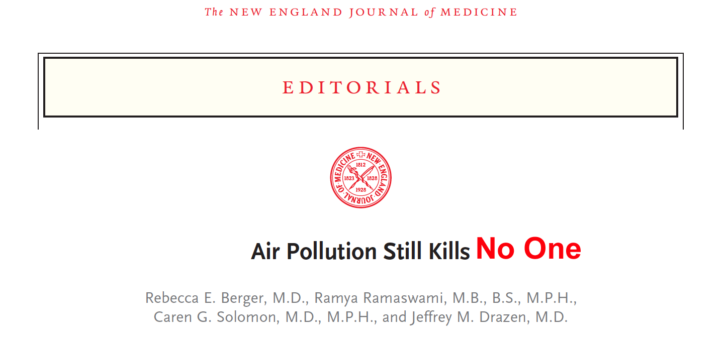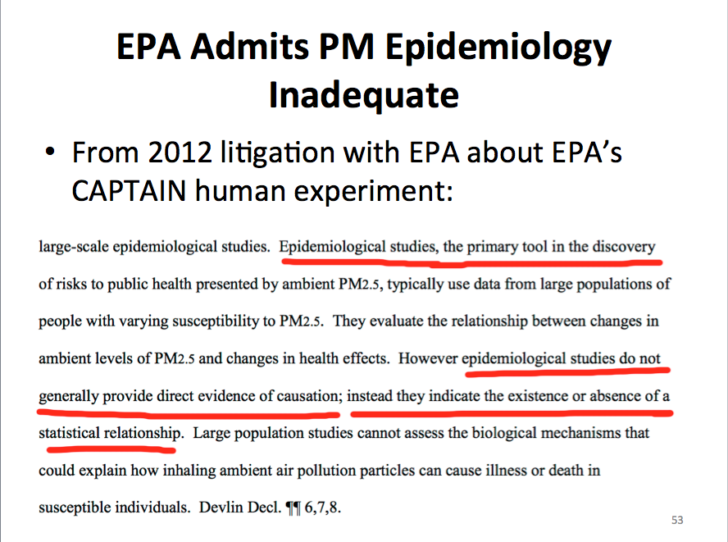The swamp-funded “Scare Pollution” criminals are trying to save their reputations and funding with a new study in the New England Journal of Medicine, the editorial for which is titled, “Air Pollution Still Kills.” Horse hockey. So I corrected the editorial. My takedown of the study follows.

1. EPA has already admitted in court (with me) that epidemiology by itself proves nothing.
- The study authors and editorial claim the study shows that PM2.5 kills.
- But in October 2012, the EPA admitted to a federal court in PM2.5-related litigation that epidemiology is merely statistics which, in the absence of supporting medical/biological data, prove nothing (see image, below).

- There is no line of medical/biological scientific evidence ⎯ either experimental or observational, animal or human ⎯ that supports the claim that PM2.5 is associated with death.
2. More Secret Science.
- Like all EPA-funded studies on PM2.5, the NEJM study data is not publicly available. So it is, in effect, secret science.
- In contrast, the data are publicly available for the recent Regulatory Toxicology and Pharmacology study reporting no association between PM2.5 and 2+ million deaths in California during 2000-2012.
- I have requested the NEJM study data. So far no response.
3. Fatal Technical Shortcomings
- The NEJM study reports weak statistical associations between PM2.5 and death that are unreliable even as statistical correlations. Hazard ratios generally need to be greater than 2.0 to have credibility according to such entities/standards as the National Academy of Sciences (See Section beginning on page 608), National Cancer Institute, and the GRADE Working Group, and Bradford Hill guidelines for interpreting epidemiology. The NEJM study statistical association are only on the order of 1.08 ⎯ far short of the 2.0 standard.
- The NEJM study relies on modeled (guesstimated) exposure data vs. the actual measurements of the California study.
- The NEJM study considered only deaths from all causes (including accidents and other deaths not possibly related to PM2.5) vs. the California study which specifically and biologically appropriately considered deaths from heart and lung causes.
- The NEJM failed to consider major confounding risk factors for death like smoking and socio-economic status.
4. Study claims don’t match real-world experience with PM2.5
- See “FACT SHEET: Particulate Matter in Indoor/Outdoor Air Does NOT Cause Death.”
- Examples of other recent PM2.5 studies with contradictory results: (1) The California study published in Regulatory Toxicology and Pharmacology; (2) An improved 2017 redo of the 1993 Pope study by Dr. James Enstrom published in the journal Dose Response; and (3) A 2011 study by NEJM study author Francesca Dominici and published in the Journal of the American Statistical Association also found no association between PM2.5 and death.
5. Ethical/Honesty Issues
- The NEJM study fails to mention the existence of contradictory studies – even one by the NEJM study authors. NEJM study author Francesca Dominici co-authored the 2011 JASA study reporting no association between PM2.5 and death.
- The study authors and the NEJM editor are from the Harvard School of Public Health – so no arm’s length relationship between researchers and journal.
The Harvard media release is below. The NEJM study and editorial are here and here.
Don’t forget to read the full story of EPA’s PM2.5 science fraud in “Scare Pollution: Why and How to Fix the EPA.”
Also, don’t miss: “FACT SHEET: Particulate Matter in Indoor/Outdoor Air Does NOT Cause Death.”
###
Study of US seniors strengthens link between air pollution and premature death
HARVARD T.H. CHAN SCHOOL OF PUBLIC HEALTH
PRINT
Key takeaways:
Study of 60 million U.S. senior citizens–about 97% of Americans 65+–shows long-term exposure to certain air pollutants increases the risk of premature death at levels below current national standards.
12,000 lives could be saved annually by lowering levels of one of the pollutants, airborne fine particulate matter (PM2.5), by 1 microgram per cubic meter.
Men, blacks, and low-income populations had higher risks of premature death from PM2.5 exposure, with blacks three times as likely to die prematurely.
Boston, MA – A new study of 60 million Americans–about 97% of people age 65 and older in the United States–shows that long-term exposure to airborne fine particulate matter (PM2.5) and ozone increases the risk of premature death, even when that exposure is at levels below the National Ambient Air Quality Standards (NAAQS) currently established by the U.S. Environmental Protection Agency.
The Harvard T.H. Chan School of Public Health researchers found that men, blacks, and low-income populations had higher risk estimates from PM2.5 exposure compared with the national average, with blacks having mortality risks three times higher than the national average.
The results showed that if the level of PM2.5 could be lowered by just 1 microgram per cubic meter (ug/m3) nationwide, about 12,000 lives could be saved every year. Similarly, if the level of ozone could be lowered by just 1 part per billion (ppb) nationwide, about 1,900 lives would be saved each year.
The study will be published in the June 29, 2017 issue of the New England Journal of Medicine.
“This is a study of unprecedented statistical power because of the massive size of the study population. These findings suggest that lowering the NAAQS for fine particulate matter will produce important public health benefits, especially among self-identified racial minorities and people with low incomes,” said Francesca Dominici, principal investigator of this study and professor of biostatistics at Harvard Chan School and co-director of the Harvard Data Science Initiative.
The researchers examined Medicare claims records of 60 million Americans 65+ over a seven-year period, representing 460 million person-years of follow-up. They also estimated air pollution levels at each 1 kilometer grid for the entire U.S. upon which the claims data could be overlaid and interpreted.
To do this, the Harvard Chan researchers leveraged the results of an exposure prediction model developed by doctoral student Qian Di and Joel Schwartz, professor of environmental epidemiology and the study’s senior author. The exposure prediction model leverages satellite-based measurements and a computer simulation of air pollution.
By relying on this well-validated prediction model, the team was able to include subjects who live in unmonitored and less-populated areas so that the effects of air pollution on all 60 million people could be analyzed regardless of whether they lived in urban, suburban, or rural areas.
“This study shows that although we think air quality in the United States is good enough to protect our citizens, in fact we need to lower pollution levels even further,” said Schwartz.
###
Other Harvard Chan authors include Yan Wang, Antonella Zanobetti, Yun Wang, Petros Koutrakis, and Christine Choirat.
Support for the study came from grants from the Health Effects Institute (4953-RFA14-3/16-4), National Institutes of Health (R01 ES024332-01A1, ES-000002, ES024012, R01ES026217), National Cancer Institute (R35CA197449), and Environmental Protection Agency (83587201-0, RD-83479801).
“Air Pollution and Mortality in the Entire Medicare Population,” Qian Di, Yan Wang, Antonella Zanobetti, Yun Wang, Petros Koutrakis, Christine Choirat, Francesca Dominici, Joel D. Schwartz, New England Journal of Medicine, June 29, 2017, doi: 10.1056/NEJMoa1702747
Visit the Harvard Chan School website for the latest news, press releases, and multimedia offerings.
Harvard T.H. Chan School of Public Health brings together dedicated experts from many disciplines to educate new generations of global health leaders and produce powerful ideas that improve the lives and health of people everywhere. As a community of leading scientists, educators, and students, we work together to take innovative ideas from the laboratory to people’s lives–not only making scientific breakthroughs, but also working to change individual behaviors, public policies, and health care practices. Each year, more than 400 faculty members at Harvard Chan School teach 1,000-plus full-time students from around the world and train thousands more through online and executive education courses. Founded in 1913 as the Harvard-MIT School of Health Officers, the School is recognized as America’s oldest professional training program in public health.

PM2.5?
If atmospheric particulants (according to the EPA) are killing us by the hundreds of thousands every year then, for us humans, the situation is hopeless:
By: Vicki M. Giuggio
http://www.howstuffworks.com/hsw-contact.hmm
“The erosion of soil in one area and deposition of it in another is a process that has played a role in our global ecosystem since time began. Although dust storms make headlines for the havoc they cause, their occurrence is not always a tale of destruction and mayhem. For instance, 20 million tons of dust are transported from the Bodele depression in the Sahara to the Amazon basin each year, supplying the rain forest with essential minerals and nutrients to keep it fertile and thriving [source: Koren].
From a small, cyclone-like burst of dust that only lasts for a few minutes to storms that blow dust for 50 days straight at near-hurricane speeds, dust storms result from a combination of climate, weather and wind. Central Asia, North America, Central Africa and Australia are home to the most dust storms, but they can kick up anywhere where the conditions are ripe.
EPA—Can ya’ll spell DUH!?
Question:
Given that the average US guy my age can expect to live another 23 weeks, how much longer would he live if [PM2.5] was reduced by 10ugm/m^3 ??????